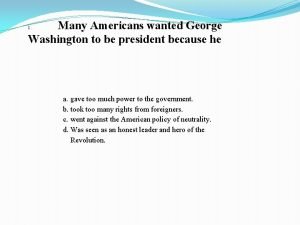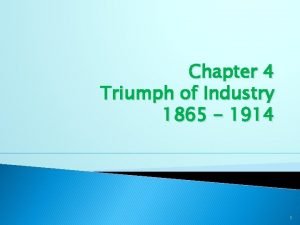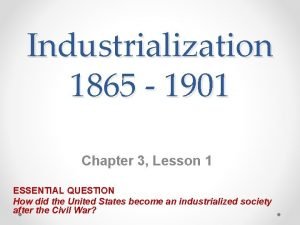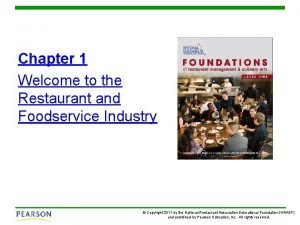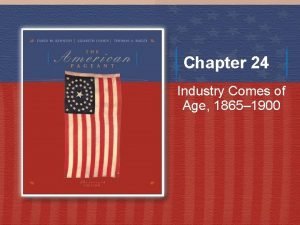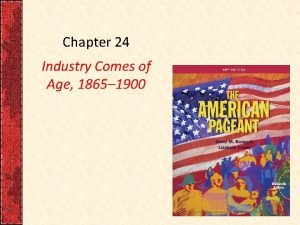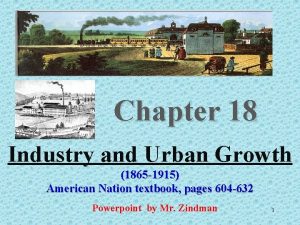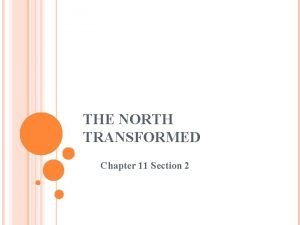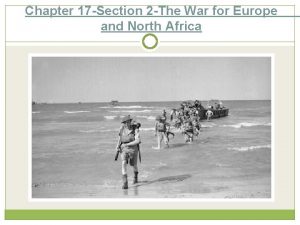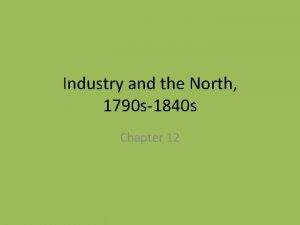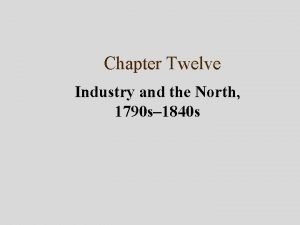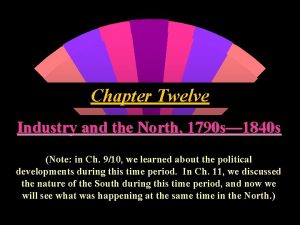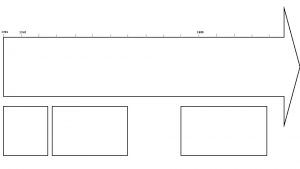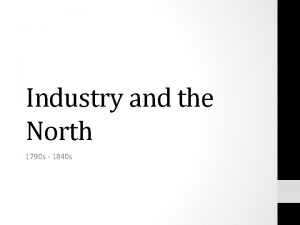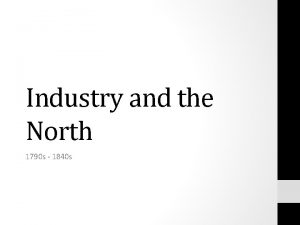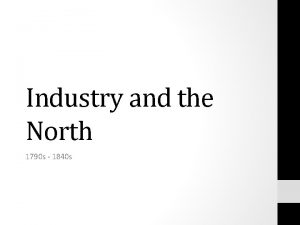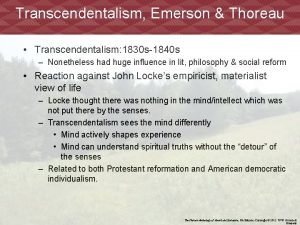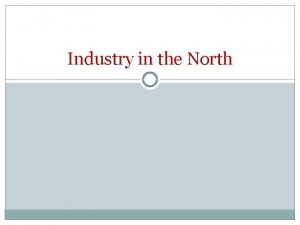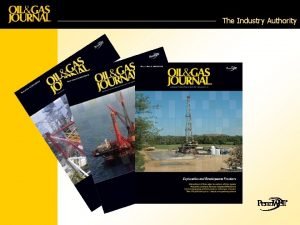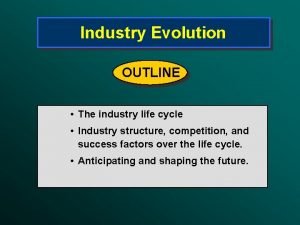Industry The North 1790 s1840 s Chapter 12







































































- Slides: 71

Industry & The North 1790 s-1840 s Chapter 12, Out of Many pp. 380 -415

Lowell, Massachusetts • • • 1820 s & 1830 s Young farm girls flock to Lowell, Mass. $3/week 12 hrs/day “Manufacturing College” Escape from rural isolation and parental supervision. --Learn “city ways. ” • Paternalistic control at factories. • By 1850 – are replaced by poor Irish immigrants.



Key Topics • Preindustrial ways of working and living. • The nature of the market revolution. • The effects of industrialization on workers in early factories. • Ways the market revolution changed the lives of ordinary people. • The emergence of the middle class.

Preindustrial Ways of Working • 97% of Americans still lived on farms. • Community based and dependent on local networks of mutual obligation.


Rural Production • Farm families/communities used a barter system. • Money rarely changed hands. –Payment in form of home-crafted item or labor. • “Just Price” was set by neighbors. • No fixed production schedule. – Did jobs when they needed to be done. • “Home & Work” were not separate locations – intermixed.

Urban Production • Skilled craftsmen controlled production. • Apprenticeships were common. • Apprentice became a “Journeyman” -worked for wages and then est. their own shop. • For men only. --Assumed that women would marry. – Needed to learn domestic skills.

Patriarchy in Family, Work, & Society • Seen in both rural and urban societies. • Fathers had authority to direct lives of family members and chose husband for daughters. • Reflected in society as a whole. • Men had all of the power. – women nor children had property or legal rights. • When a man died, his son inherited his property.

The Social Order • Fixed social hierarchy. • Great importance placed on rank and status. --Distinguished by dress and manner. • Artisans gained increased wealth, but did not directly challenge the elite.

The Transportation Revolution • Between 1800 -1840, the US saw revolutionary improvements in transportation. • Encouraged Americans to “look beyond” their communities. • Led to increased urbanization.

Roads • Mud and snow made travel by horseback difficult – slow and dangerous. • Localities contract private turnpike companies to maintain roads – but still remained poor.

The National Road • Was built in 1808. • Single greatest transportation expense (7 million). • Built of gravel on a stone foundation it crossed the Appalachian Mtns. at Cumberland, Maryland – opening up the West! • Built in stages – reached almost to the Miss. River. • Tied the East and West together -- strong evidence of the nations commitment to both expansion and cohesion. -- National community!



Canals & Steamboats • Roads did not work well in the commercial sense. • Canals were the answer to improve East to West cargo transportation.

The Erie Canal • Most famous canal of the era. • Brainchild of NY governor, De. Witt Clinton – who envisioned a “link between NYC and the Great Lakes” through the Hudson River. • 364 miles long – stretches from Albany to Buffalo • Originally coined as “Clinton’s Ditch”

• 27 miles long • Took 9 years to build. • 83 locks • 300 bridges • Farmers worked for $8/month • Replaced by Irish contract workers – cents/day plus room and board. • Other heavy construction work performed by immigrants. 50

• October 26 th, 1825 the Erie Canal was declared “Open for business. ” • The first boat to travel was named The Seneca. --Incredible speed of 4 mph. • …. Ironically, the Seneca Indians, for whom the boat was named, had been removed from the path of the canal and confined to a small reservation.

• The canal provided passage for people and goods. • Farm families now purchased goods previously crafted in their homes. • Rapid decline of homespun cloth because of the canal.

• Utica, Rochester, Buffalo – became instant cities. • Greatest beneficiary was New York City. • NY merchants turned away from Europe and now looked to America’s heartland.

As a famous song put it: “You’ll always know your neighbor, You’ll always know your pal, If you’ve ever navigated On the Erie Canal. ”

“Copy Cats” • Other states follow suit and build canals of their own. • Between 1820 and 1840, $200 million was invested in canal building. • The Erie Canal collected $8. 5 million in tolls in its first 9 years of operation. • Canal building ended the geographical isolation of most of the country.

Railroads • “Railroad Mania” quickly surpassed canal mania. • The south (least industrialized) had fewer railroads – the North laid a dense network of rail lines that reached west beyond the Mississippi.

Glitches • Locomotives had to be heavy. • Required iron rather than wooden rails. • At first, railroad iron was imported from England. • Required solid gravel roadbed and strong wooden ties. • Arranging steady supplies and construction itself, remained an engineering challenge.

Effects of the Transportation Revolution • Fueled economic growth by making distant market accessible. • $500 million of foreign investments between 1790 and 1861. • Increased risk-taking, invention and innovation. • Allowed people to MOVE… rather easily.

• • Americans began moving farther away. Disease moved with them. Localized epidemics, spread as travel did. St. Louis and Cincinnati lost 10% of their population to disease. • Cholera killed gold-rushers before they reached California.

The Market Revolution • The most fundamental change American communities ever experienced, was the outcome of 3 interrelated developments: 1. Improvements in transportation 2. Commercialization 3. Industrialization

• Commercialization = replacement of household self-sufficiency and barter with the production of goods for a cash market. • Industrialization = the use of powerdriven machinery to produce goods once made by hand.

The Accumulation of Capital • Eastern seaboard cities made huge profit gains through international shipping. • Success stories of the “American Dream” became more commonplace.

John Jacob Astor • Arrived penniless from Germany in 1784. • Made his fortune in the Pacific NW fur trade with China – Est. the “American Fur Co. ” • Made a second fortune in NY real estate. • Retired in 1834 with $25 million • “Wealthiest Man in America”


Banks & Wealth • Banks provided much of the capital for new investments. • A significant amount though, was raised through family connections. • Wealthy families started to consolidate wealth through marriages. • Most northern development was paid for by southern cotton produced by enslaved African American labor.

I HEART ‘MERICA • The willingness of Americans to “think big, ” take risks, and invest large sums of money was caused by American nationalism.

The Putting-Out System • People still produced goods at home, but under the direction of a merchant, who “put out” the raw materials to them. • Paid them a certain sum per finished piece. • Sold the completed item to a distant market.

“ten-footers”


• The putting-out system moved the control of production from the individual artisan to the merchant capitalists. • A national market was being born.

The Spread of Commercial Markets • Because of the putting-out system – farmers move away from barter system and into a larger market economy. • Commercialization was born! • The existence of a cash market was an important spur to westward expansion.

Commercial Agriculture in the Old Northwest • New transportation methods allowed farmers to get their produce to market faster. • Improvements in farm technology allowed farmers to grow more food. • Inexpensive land in America’s Heartland allowed for farmers to grow huge surpluses.

Government Policy • Strongly encouraged western settlement. • $2. 00/acre for a min. of 320 acres in 1800. • $1. 25/acre for 80 acres in 1820.

• The need for cash pushed people into commercial agriculture. • Commercial farming aided by transportation revolution. • Some farmers only farmed out of speculation – hoped their land would increase in value and could sell quickly.

New Technology for Farming • John Deere’s steel plow (invented in 1837) • Cyrus Mc. Cormick’s reaper (patented in 1834). • Farmers were richer, but more economically vulnerable than they had been before.



British Technology & American Industry • Industrialization began in Britain in the 18 th. C. • Was a result of technological changes in the textile industry. • Industrialization required workers to work in factories and “pace themselves to the rhythms of power driven machinery. ”

• The Americans had to copy the British to industrialize quickly. • Samuel Slater - spy? Brought British Machinery plans and ideas to America and built Slater’s Mill – 1 st water powered cotton textile mill. (Rhode Island) • Workforce came primarily from young children (ages 7 -12) and women.



The Lowell Mills (Map pg. 397) • Francis Cabot Lowell stole machine ideas from the British. (industrial spy) • Began building machinery for spinning cotton – and invented a power loom. • Built first LARGE Mill in Waltham, Mass. • Lowell, Mass. Was soon born thereafter.

“The American System of Manufactures” • Interchangeable Parts – first realized in gun manufacturing – revolutionized industrialization. • Huge source of national pride. • America now mass-produced high quality goods much earlier than Britain or any other European country.




From Artisan to Worker • Wage laborers rose from 12% in 1800 to 40% by 1860 • Most of these workers were employed in the North. • ½ were women performing outwork in their homes. • ALL were participating in fundamental person and social changes!

Personal Relationships • Apprentice system eventually replaced by child labor. • Breakdown of the family work-system. • Working at Lowell provided women new options. • Patriarchal control was challenged.

• Southern slave owners compare themselves to northern employers and their use of “wage slaves. ” • Southerners were right…this was a heartless system. • But – Northerners were right… industrialization was certainly freer than the slave system.

Time, Work, & Leisure • Factory work did not allow flexibility. • Work and leisure time used to be blended, now it was seen as separate. • Local taverns become hot-spots for Sunday leisure. • Community-wide celebrations became common in rural areas. • Spectator sports become popular.

Early Strikes • Rural women led early labor strikes. • 1824 women workers at a Pawtucket, Rhode Island textile mill led their coworkers (female and male) out on strike to protest wage cuts and longer hours. • 1834 – Strikes at Lowell Factory – 800 women participated. • Most strikes were unsuccessful.


A New Social Order • Emergence of the American Middle-Class • Second Great Awakening takes root on the East Coast. – Revival meetings take place. • Prayer meetings take place in schools and businesses. -- Reach all classes of society. • Catherine Beecher’s Treatise on Domestic Economy is published in 1841.


Sentimentalism • Sprang from nostalgia for the imagined trust and security of the familiar, face-tface life of the preindustrial age. *Thomas Hardy: The Ruined Maid* • Women begin reading sentimental novels. • Women begin writing for other women. • New “female” social codes were formed.

Transcendentalism and Self-Reliance • Ralph Waldo Emerson. (writer, secular minister) • Transcendentalism – a romantic philosophical theory claiming that there was an ideal, intuitive reality transcending ordinary life. • “Nature” (1836)

• “Standing on the bare ground – my head bathed by the blithe air, and uplifted into infinite space – all mean egotism vanishes. I become a transparent Eyeball; I am nothing; I see all; the currents of the Universal Being circulate through me; I am part and parcel of God. ”


• Henry David Thoreau, Walden (1854) • Margaret Fuller, Woman in the Nineteenth Century (1845)


• Sentimentalism, transcendentalism, and evangelical religion all helped the new middle-class to forge values and beliefs that were appropriate to their social roles.

SO WHAT? • 3 -6 sentence summary of notes.
 1790 foreign policy
1790 foreign policy Us map 1790
Us map 1790 Coquille meaning
Coquille meaning Which statement best characterizes american farmers in 1790
Which statement best characterizes american farmers in 1790 True north vs magnetic north
True north vs magnetic north North east and north cumbria integrated care system
North east and north cumbria integrated care system Lesson quiz 14-1 north and south
Lesson quiz 14-1 north and south The north pole ____ a latitude of 90 degrees north
The north pole ____ a latitude of 90 degrees north Hát kết hợp bộ gõ cơ thể
Hát kết hợp bộ gõ cơ thể Slidetodoc
Slidetodoc Bổ thể
Bổ thể Tỉ lệ cơ thể trẻ em
Tỉ lệ cơ thể trẻ em Voi kéo gỗ như thế nào
Voi kéo gỗ như thế nào Glasgow thang điểm
Glasgow thang điểm Hát lên người ơi alleluia
Hát lên người ơi alleluia Kể tên các môn thể thao
Kể tên các môn thể thao Thế nào là hệ số cao nhất
Thế nào là hệ số cao nhất Các châu lục và đại dương trên thế giới
Các châu lục và đại dương trên thế giới Công của trọng lực
Công của trọng lực Trời xanh đây là của chúng ta thể thơ
Trời xanh đây là của chúng ta thể thơ Mật thư anh em như thể tay chân
Mật thư anh em như thể tay chân 101012 bằng
101012 bằng độ dài liên kết
độ dài liên kết Các châu lục và đại dương trên thế giới
Các châu lục và đại dương trên thế giới Thơ thất ngôn tứ tuyệt đường luật
Thơ thất ngôn tứ tuyệt đường luật Quá trình desamine hóa có thể tạo ra
Quá trình desamine hóa có thể tạo ra Một số thể thơ truyền thống
Một số thể thơ truyền thống Cái miệng xinh xinh thế chỉ nói điều hay thôi
Cái miệng xinh xinh thế chỉ nói điều hay thôi Vẽ hình chiếu vuông góc của vật thể sau
Vẽ hình chiếu vuông góc của vật thể sau Thế nào là sự mỏi cơ
Thế nào là sự mỏi cơ đặc điểm cơ thể của người tối cổ
đặc điểm cơ thể của người tối cổ V cc
V cc Vẽ hình chiếu đứng bằng cạnh của vật thể
Vẽ hình chiếu đứng bằng cạnh của vật thể Phối cảnh
Phối cảnh Thẻ vin
Thẻ vin đại từ thay thế
đại từ thay thế điện thế nghỉ
điện thế nghỉ Tư thế ngồi viết
Tư thế ngồi viết Diễn thế sinh thái là
Diễn thế sinh thái là Dạng đột biến một nhiễm là
Dạng đột biến một nhiễm là Các số nguyên tố
Các số nguyên tố Tư thế ngồi viết
Tư thế ngồi viết Lời thề hippocrates
Lời thề hippocrates Thiếu nhi thế giới liên hoan
Thiếu nhi thế giới liên hoan ưu thế lai là gì
ưu thế lai là gì Sự nuôi và dạy con của hươu
Sự nuôi và dạy con của hươu Khi nào hổ con có thể sống độc lập
Khi nào hổ con có thể sống độc lập Sơ đồ cơ thể người
Sơ đồ cơ thể người Từ ngữ thể hiện lòng nhân hậu
Từ ngữ thể hiện lòng nhân hậu Thế nào là mạng điện lắp đặt kiểu nổi
Thế nào là mạng điện lắp đặt kiểu nổi Chapter 5 industry and competitor analysis
Chapter 5 industry and competitor analysis Chapter 4 the triumph of industry
Chapter 4 the triumph of industry Chapter 4 the horticulture industry answer key
Chapter 4 the horticulture industry answer key Chapter 1 welcome to the industry
Chapter 1 welcome to the industry Chapter 3 industrialization (1865 to 1901 answers)
Chapter 3 industrialization (1865 to 1901 answers) Chapter 1 welcome to the industry
Chapter 1 welcome to the industry The symbol of welcome, friendship and hospitality is a(n)
The symbol of welcome, friendship and hospitality is a(n) Chapter 24 industry comes of age
Chapter 24 industry comes of age Industry comes of age
Industry comes of age Chapter 18 industry and urban growth
Chapter 18 industry and urban growth Chapter 11 section 2 the north transformed
Chapter 11 section 2 the north transformed Chapter 20 section 2 european nations settle north america
Chapter 20 section 2 european nations settle north america Tci chapter 19 the worlds of north and south
Tci chapter 19 the worlds of north and south Lesson 1 physical geography of southeast asia
Lesson 1 physical geography of southeast asia Lesson 4 rivalry in north america
Lesson 4 rivalry in north america European nations settle north america
European nations settle north america The war for europe and north africa chapter 17 section 2
The war for europe and north africa chapter 17 section 2 The war for europe and north africa chapter 17 section 2
The war for europe and north africa chapter 17 section 2 Chapter 7 natural environments of north america
Chapter 7 natural environments of north america Chapter 6 the duel for north america
Chapter 6 the duel for north america War of jenkins ear definition apush
War of jenkins ear definition apush Chapter 6 the duel for north america
Chapter 6 the duel for north america



